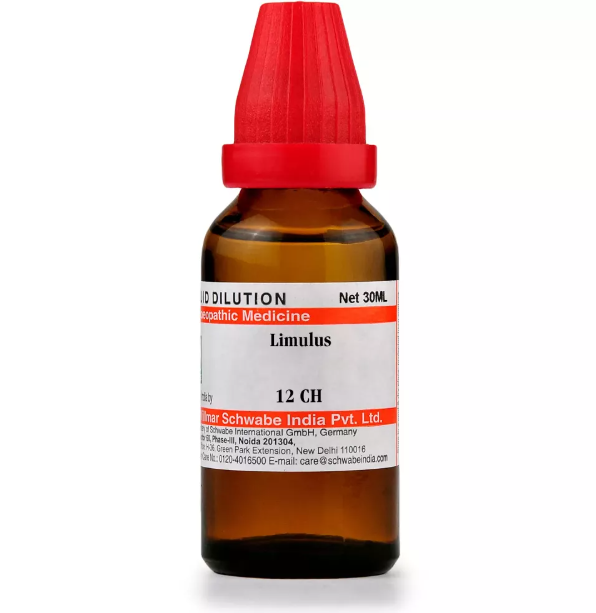LIMULUS CYCLOPS (XIPHOSURA) 6C, 12C, 30C, 200C, 1M, 10M USES AND SYMPTOMS
 LIMULUS CYCLOPS (XIPHOSURA)
LIMULUS CYCLOPS (XIPHOSURA)
(Horse Foot, King Crab)
Lim.
Limulus Cyclops was introduced by C. Hering and partially proved by him and Lippe. Hering discovered the King Crab’s blood was blue and contained copper, potentially useful for cholera treatment. Further testing is needed, but current symptoms suggest this is possible. Hering often explored new paths in practical therapeutics.
Physical and mental exhaustion; drowsiness after sea bathing. Gastroenteric symptoms. Painful fullness on the entire right side of the body.
Head: Mental depression. Difficulty remembering names, confusion with heat and rush of blood to the face, worse when meditating. Pain behind the left eyeball.
Nose: Fluent coryza. Sneezing, worse after drinking water. Constant nasal dripping. Pressure above the nose and behind the eyes.
Abdomen: Colic with heat. Cramp-like pain with watery stools. Abdomen hot and constricted. Piles, anal constriction.
Respiratory: Husky voice. Dyspnea after drinking water. Chest oppression.
Extremities: Crural neuralgia. Aching and numb soles. Pain in the right hip joint. Sore heels.
Skin: Itching spots and vesicles on the face and hands. Burning palms.
Relationship: Compare with Aster., Hom., Cupr.
SYMPTOMS OF LIMULUS CYCLOPS (XIPHOSURA)
Head:
Mental depression
Difficulty remembering names
Confusion with heat and rush of blood to the face (apoplexy), worse when meditating
Pain behind the left eyeball
Nose:
Fluent coryza
Sneezing, worse after drinking water
Constant nasal dripping
Pressure above the nose and behind the eyes
Abdomen:
Colic with heat
Cramp-like pain with watery stools
Abdomen hot and constricted
Piles
Anal constriction
Respiratory:
Husky voice
Dyspnea after drinking water
Chest oppression
Extremities:
Crural neuralgia
Aching and numb soles
Pain in the right hip joint
Sore heels
Skin:
Itching spots and vesicles on the face and hands
Burning palms
selection of the potency
Individualization:
- Homeopathy is based on the principle of treating the individual, not just the disease. The unique symptoms and characteristics of the person are crucial in determining the most suitable potency.
Intensity of Symptoms:
- The intensity of the symptoms guides the choice of potency. If the symptoms are intense and acute, a lower potency (e.g., 6C, 30C) might be considered. For chronic conditions with less intensity, higher potencies (e.g., 200C, 1M) may be appropriate.
Sensitivity of the Patient:
- Some individuals are more sensitive to homeopathic remedies, while others may require higher potencies. The practitioner considers the patient’s sensitivity when selecting the potency.
Acute vs. Chronic Conditions:
- Lower potencies are often used for acute conditions, while higher potencies may be considered for chronic or long-standing issues.
Previous Response to Potencies:
- The patient’s response to previous homeopathic treatments helps guide the choice of potency. If a particular potency has been effective in the past, it may be repeated or adjusted as needed.
Vital Force and Susceptibility:
- Homeopathy views illness as a disturbance in the vital force. The practitioner assesses the patient’s overall vitality and susceptibility to determine the appropriate potency.
Aggravation or Amelioration:
- The direction of the symptom response (aggravation or amelioration) after taking a remedy can influence the choice of potency.
Miasmatic Considerations:
- In classical homeopathy, the concept of miasms (inherited disease tendencies) is considered. The practitioner take this into account when selecting the potency.
Practitioner Experience:
- The experience and preference of the homeopathic practitioner play a role. Some practitioners may have success with certain potencies based on their clinical experience.
SAFETY INFORMATION
- Do not exceed the recommended dose by physician
- Keep out of the reach of children
- Store in a cool dry place away from direct sunlight
- Maintain half an hour gap between food/drink/any other medicines and homoeopathic medicine
- Avoid any strong smell in the mouth while taking medicine e.g. camphor, garlic, onion, coffee, hing
Medicine images use for reference only selection of homeopathic medicine depends on the individual’s specific symptoms and overall constitution. Moreover, homeopathy is a holistic system of medicine that treats the individual as a whole. In addition to addressing the physical symptoms, it takes into account the emotional and mental state of the person. Consequently, it’s crucial to consult with a qualified homeopathic practitioner for personalized treatment.
The information provided on this website is intended solely for educational purposes. Always seek the advice of your physician or other qualified health provider.
